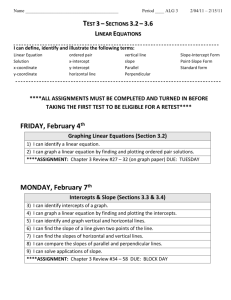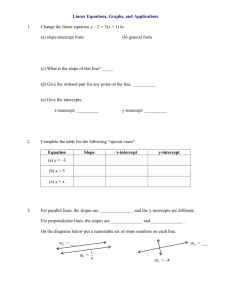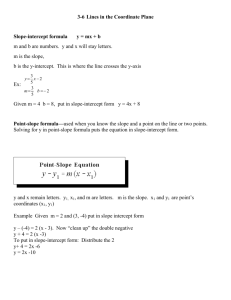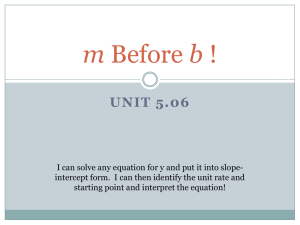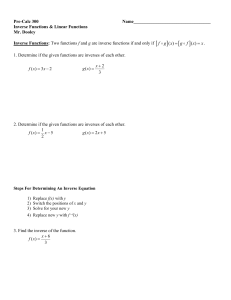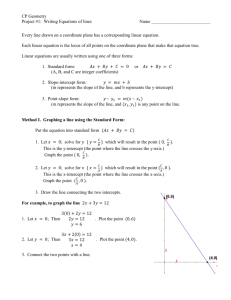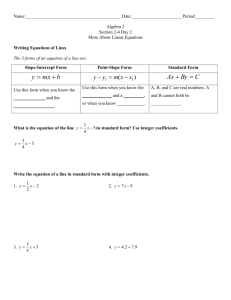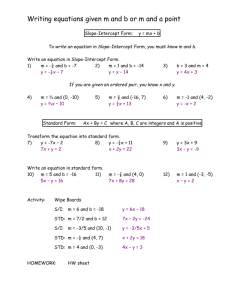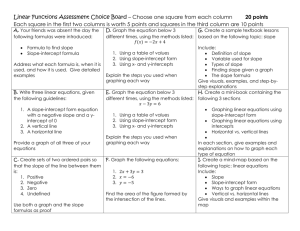Overview
advertisement
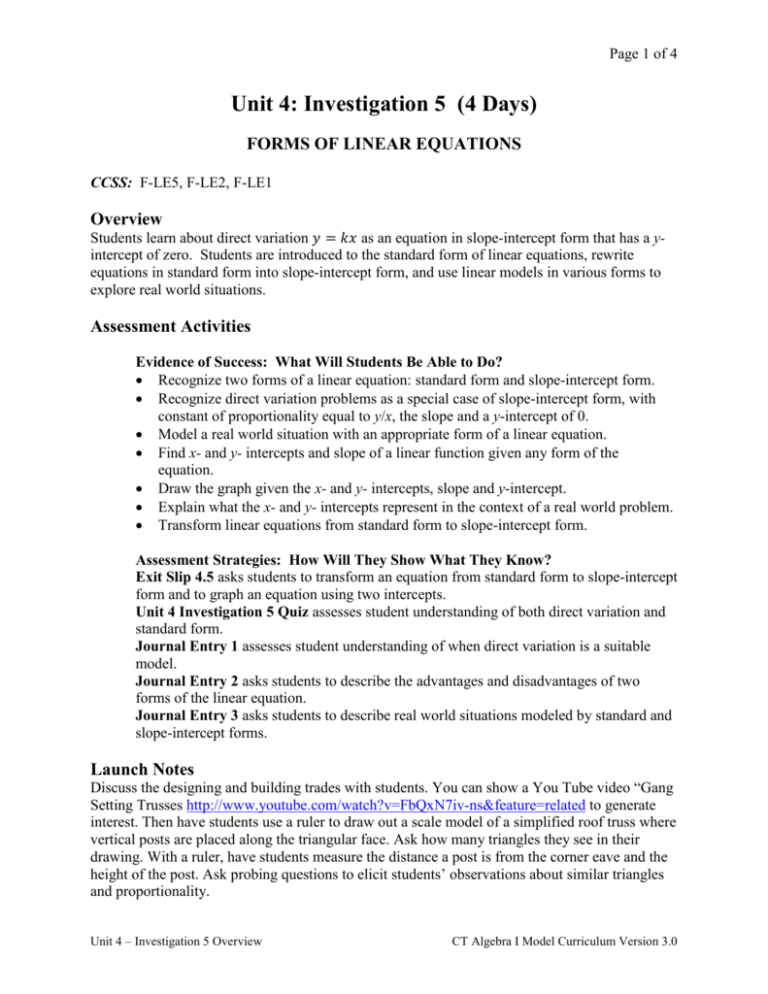
Page 1 of 4 Unit 4: Investigation 5 (4 Days) FORMS OF LINEAR EQUATIONS CCSS: F-LE5, F-LE2, F-LE1 Overview Students learn about direct variation 𝑦 = 𝑘𝑥 as an equation in slope-intercept form that has a yintercept of zero. Students are introduced to the standard form of linear equations, rewrite equations in standard form into slope-intercept form, and use linear models in various forms to explore real world situations. Assessment Activities Evidence of Success: What Will Students Be Able to Do? Recognize two forms of a linear equation: standard form and slope-intercept form. Recognize direct variation problems as a special case of slope-intercept form, with constant of proportionality equal to y/x, the slope and a y-intercept of 0. Model a real world situation with an appropriate form of a linear equation. Find x- and y- intercepts and slope of a linear function given any form of the equation. Draw the graph given the x- and y- intercepts, slope and y-intercept. Explain what the x- and y- intercepts represent in the context of a real world problem. Transform linear equations from standard form to slope-intercept form. Assessment Strategies: How Will They Show What They Know? Exit Slip 4.5 asks students to transform an equation from standard form to slope-intercept form and to graph an equation using two intercepts. Unit 4 Investigation 5 Quiz assesses student understanding of both direct variation and standard form. Journal Entry 1 assesses student understanding of when direct variation is a suitable model. Journal Entry 2 asks students to describe the advantages and disadvantages of two forms of the linear equation. Journal Entry 3 asks students to describe real world situations modeled by standard and slope-intercept forms. Launch Notes Discuss the designing and building trades with students. You can show a You Tube video “Gang Setting Trusses http://www.youtube.com/watch?v=FbQxN7iv-ns&feature=related to generate interest. Then have students use a ruler to draw out a scale model of a simplified roof truss where vertical posts are placed along the triangular face. Ask how many triangles they see in their drawing. With a ruler, have students measure the distance a post is from the corner eave and the height of the post. Ask probing questions to elicit students’ observations about similar triangles and proportionality. Unit 4 – Investigation 5 Overview CT Algebra I Model Curriculum Version 3.0 Page 2 of 4 Closure Notes Students should be very comfortable using standard form and slope-intercept form to model and explore real world situations. They should be able to identify the advantages of each form, be able to choose the appropriate form, and recognize the equivalence of the forms. Teaching Strategies I. In Activity 4.5.1 Direct Variation, students explore direct variation problems in real world situations. Students should recognize that direct variation occurs when a linear function has a y-intercept of 0 and that a direct variation equation in the form 𝑦 = 𝑘𝑥 is a special case of the slope-intercept form. Students may work in small groups or pairs to construct and graph direct variation functions. In addition to the applications included in Activity 4.5.1, you may choose to present or discuss the following examples of direct variation: (a) Model the cost to put gasoline that costs $2.89/gallon in a car based on the number of gallons of gasoline purchased. (b) Find the amount of drug that a dog needs if it should vary with the weight of the dog. (c) Find the total tutoring bill if a tutor charges $45 per hour. (d) Revisit some distance, rate and time problems. Through exploration, students will discover how to determine whether or not a linear function scenario is a direct variation scenario. Assign Activity 4.5.2 More Direct Variation for more practice. Journal Entry 1 Which of the following two scenarios is direct variation and which is not? Explain your answer. A. The plumber charges $60 per hour and a $75 fee for the house call. B. The auto repair shop charges $80 per hour to fix my car. Unit 4 – Investigation 5 Overview CT Algebra I Model Curriculum Version 3.0 Page 3 of 4 II. Next, introduce the standard form of linear equations. The standard form lends itself well to situations when a constant value results from the combination of two rates, such as the rate charged for a child’s ticket and the rate charged for an adult ticket combined. One example is to ask students what combinations of $3 children tickets and $5 adult tickets need to be sold to make $90. Students may like guessing coin values: what combinations of dimes and quarters will total $2? Discuss discrete versus continuous graphs: one can’t sell 1.5 tickets, but if you combine cashews at $8 a pound with peanuts at $3 a pound the function is continuous. Students should practice finding the intercepts of a line in standard form by solving for x when y = 0 and solving for y when x = 0. Students will then learn how to use the intercept graphing method as a method for determining the slope of a line by calculating the ratio of the rise and the run between the intercepts. Students should then practice transforming equations from standard form to slope-intercept form and then graph the equation. Graphical representations and algebraic transformations highlight the mathematical equivalence of an equation regardless of its form. See Activity 4.5.3 Standard Form of a Linear Equation. You can assess understanding of these outcomes with Exit Slip 4.5. Continue to practice problems in standard form mixed with problems that lend themselves to slope-intercept form. Have students articulate the advantages of each form in a journal prompt. See Activity 4.5.4 More Standard Form and Activity 4.5.5 Practice with Standard Form and Slope-Intercept Form. At the end of this investigation you may give students Unit 4 Investigation 5 Quiz. Journal Entry 2 What are the advantages of graphing an equation in slope-intercept form, and the advantages of graphing an equation in standard form? Differentiated Instruction (For Learners Needing More Help) Maintain students’ note cards and the class bulletin board. Include directions on how to find the constant of variation and how to graph a function in standard form by finding intercepts. A table with 0 filled in for x on the first row and 0 filled in for y on the second row is a visual reminder for students to substitute 0 in for x and solve for y, and substitute 0 in for y and solve for x. x 0 ? Unit 4 – Investigation 5 Overview y ? 0 CT Algebra I Model Curriculum Version 3.0 Page 4 of 4 Differentiated Instruction (Enrichment) Ask students to research the “rule of thumb” for estimating the distance a person is from lightning based on the time lapse between when a person sees the lightning bolt and hears the thunder. Ask students to justify why this rule works. Group Activity Activity 4.5.5 Practice with Standard Form and Slope-Intercept Form lends itself well to group problem solving since the problems have little scaffolding and the students have to choose which form of a linear equation to use. Journal Prompt 3 When modeling a real life situation, when do you use slope-intercept from and when do you use standard form? Resources and Materials Activity 4.5.1 Direct Variation Activity 4.5.2 More Direct Variation Activity 4.5.3 Standard Form of a Linear Equation Activity 4.5.4 More Standard Form Activity 4.5.5 Practice with Standard Form and Slope-Intercept Form Exit Slip 4.5 Unit 4 Investigation 5 Quiz Rulers Bulletin Board for key concepts Student Journals Graphing Calculators Slope intercept game links: http://hotmath.com/hotmath_help/games/kp/kp_hotmath_sound.swf Video on roof trusses http://www.youtube.com/watch?v=FbQxN7iv-ns&feature=related Unit 4 – Investigation 5 Overview CT Algebra I Model Curriculum Version 3.0
